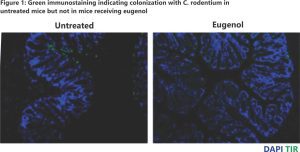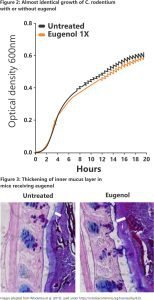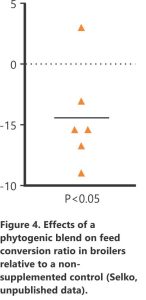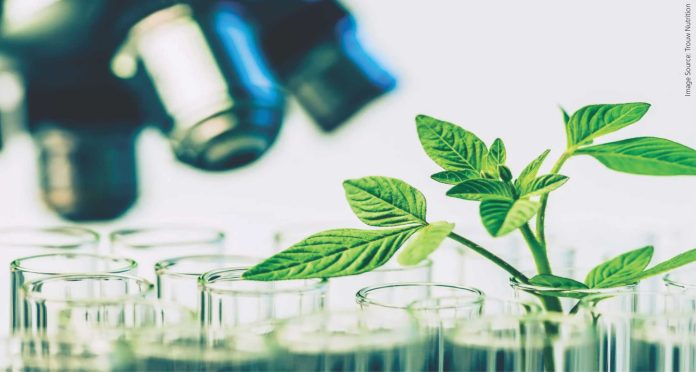

Phytogenics were introduced to animal nutrition decades ago with a specific objective: to find alternatives for the use of antibiotics as growth promoters. Considering that narrow focus, phytogenics – specifically essential oils – were screened for antimicrobial properties and selected for their ability to kill relevant pathogenic bacteria. The mode of action for phytogenics in the animal can be used to truly harness the full power of this fascinating category of molecules. Phytogenic additives present a plausible alternative as they enhance several important processes in the animal body. Phytogenic feed additives may be included among supplements that are aimed to positively affect feed quality, health of animals as well as animal products by means of their specifically efficacious substances.
As feed additives, phytogenic compounds have the potential to modulate signal transduction pathways relevant to physiological processes such as nutrient absorption or immune response, to name just two examples. When used at the right dosage, phytogenics are a powerful tool in supporting the animal to come closer to its genetic potential.
Focus on the Gut – as much more than a digestive organ
One of the focus areas in broiler production is the intestinal tract because it is one of the most prominent sites of interaction of the animal with its environment. Moreover, it is the site where dietary energy and nutrients need to be optimally digested, absorbed, and converted into molecules required for maintenance and growth. Better digestibility of nutrients, or simply, better digestion, contributes to better feed efficiency. Poor digestibility of a diet is not only visible in sub-optimal feed efficiency but also in the negative effects that impact the digestive tract directly. So, when focusing on improving the production efficiency of broilers, the gut is the focus area to be looked at.
Traditionally, animal nutritionists have focused on formulating diets that meet the animal’s nutritional requirements at minimum cost; on exploring ways to remove or mitigate the effects of anti-nutritional factors in feed raw materials; and on manipulating the gut ecosystem by using antibiotics, pre-and probiotics, and other compounds. Only in recent decades have researchers realized that the gut serves as so much more than a digestive organ.
Furness et al. (2013) describe the gut as a sensory organ, which detects and processes ‘messages’ from its environment through a myriad of receptors located on intestinal cells facing the gut lumen. Targeting these receptors through molecules supplied in the animal’s diet can trigger systemic physiological responses that in turn affect metabolism, immunity, hormonal secretion, inflammation, etc., and, ultimately, animal performance.
Rethinking the role of phytogenics – considering the mode of action
An imbalance in the animal’s gastrointestinal microbiota due to dietary or environmental changes is damaging to the growth, health, and feed conversion of the animal. In contrast, an ideal, stabilized microbiota allows optimum growth performance (Schaedler 1973).
Co-evolved during the ever-ongoing ‘animal plant warfare’, plant bio-actives (i.e., phytogenics) have the potential to act upon said receptors along the animals’ gastrointestinal tract. These receptors are conserved across species, which is why mechanistic effects will be similar independent of species though their relevance and impact on productive outcomes may shift.
Wlodarska et al. (2015) studied the ability of six different phytogenic compounds on mice’ resistance to enteric pathogen infection. Figure 1,2&3 shows that mice receiving eugenol (the main component of clove essential oil) had reduced colonization of Citrobacter rodentium, an enteric pathogen. Surprisingly, however, the growth of C. rodentium appeared to be quite unaffected by eugenol as such. Instead, eugenol has been shown to strengthen the mucosal barrier that protects against invading pathogens and disease, rather than affecting the pathogen directly.




Usage considerations in phytogenics
The level of standardization of phytogenics additives has increased over the last few decades. Improvements have been observed in most of the investigations to evaluate the influence of phytogenics on digestibility, morphology, and inflammatory processes in the digestive tract, as well as on zootechnical parameters. However, aspects like undesired effects and effects of over-dosage need to be further investigated in both, in vitro and in vivo trials to ensure the safe and productive use of the phytogenics used as additives.
It is important to realize that many phytogenics show a biphasic dose response, meaning that their effects can be the complete opposite depending on the dose (Jodynis-Liebert and Kujawska, 2020). For example, low doses of a specific phytogenic compound can act as an anti-inflammatory, but the same phytogenic can trigger an inflammatory response at higher levels. Selkos’ own research with a phytogenic



Future considerations of phytogenics
Based on the literature and data available, phytogenic based additives comprising of single or combinations of components have been focussed for their potential to as a global trend to restrict use of AGPs and antimicrobials in animal production. The lens for phytogenics should be broadened beyond their in vitro antimicrobial effects and their use as agents in a narrow, oversimplified silver-bullet approach. There are clear examples demonstrating that phytogenics offer opportunities to improve farm economics and more.
The future consideration of the use of phytogenics in the commercial livestock industry should be aimed at addressing the following issues necessary for sustainable animal production primarily on
- Production efficiency -maintaining animal production and profitability.
- Animal health and welfare – improving animal health by reducing the use of the rapeutic antibiotics.
- Consumer safety – reducing the risk of bacterial resistance.
- Public acceptance – by using reliable ingredients in the food chain.
- Sustainability and Environmental protection- conserving resources and improving feed efficiency.
A growing world population and more people entering the middle class are fuelling the demand for animal protein (especially poultry) and highlighting the need for efficient production practices.
The boundaries of animals’ genetic potential have expanded in recent decades, contributing to greatly improved animal performance indicators such as average daily gain and feed conversion ratio (FCR). Genetics and environment are interdependent. Today’s performance levels suggest that the environment often is suboptimal and provide a powerful incentive to help close the gap between an animal’s performance and its genetic potential.
Recognizing phytogenics’ contribution to the host’s natural defense mechanisms as well as robust physiological functions in all kinds of environmental conditions will help harness the true potential of phytogenics in supporting efficient and profitable livestock production.
By Dr Shiva Kumar, Trouw Nutrition South Asia













